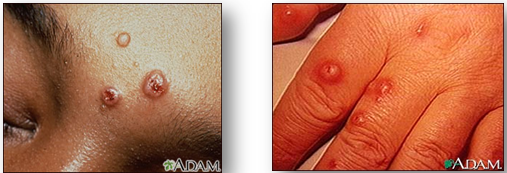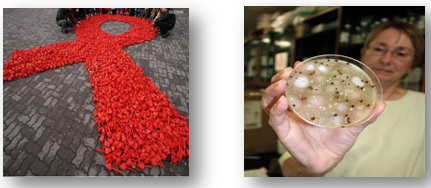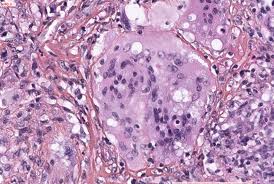Cryptococcosis is an infection caused by fungi that belong to the genus Cryptococcus. There are over 30 different species of Cryptococcus. The two common species are
- Cryptococcus neoformans and
- Cryptococcus gattii.
C. neoformans can be found in soil throughout the world. People at risk can become infected after inhaling microscopic, airborne fungal spores.Cryptococcosis is believed to be acquired by inhalation of the infectious propagule from the environment.
Cryptococcus neoformans (anamorph) or Filobasidiella neoformans (teleomorph) is an encapsulated heterosexuality fungus that usually grows as a yeast and replicates by budding. It is distributed worldwide and is often found in soil contaminated by avian feces.

Cryptococcus gattii is a type of Cryptococcus that is acquired by inhalation of airborne plant material (propagules or reproductive plant parts like a seed or spore).
Causative agent
Filobasidiella neoformans is a causative agent of cryptococcosis, also known as Busse-Buschke disease, a disease that ranges from asymptomatic infection of airways to severe meningitis.
How can produce the diseases:
The fungus(Cryptococcus neoformans) that causes this disease, is ordinarily found in soil. It enters and infects the body through the lungs. Once inhaled, infection with cryptococcosis may go away on its own, remain in the lungs only, or spread throughout the body.
In people with a normal immune system, the lung (pulmonary) form of the infection may have no symptoms. In people with weakened immune systems, the Cryptococcus organism may spread to the brain.
Signs and Symptoms:
- Blurred vision or double vision (diplopia)
- Bone pain or tenderness of the breastbone (sternum)
- Chest pain
- Confusion
- Cough dry
- Fatigue
- Fever
- Headache
- Nausea
- Skin rash, including pinpoint red spots (petechiae), ulcers, or other skin lesions
- Sweating — unusual, excessive at night
- Swollen glands
- Unintentional weight loss

Note: People with a normal immune system may have no symptoms at all.
Treatment of cryptococcosis diseases:
These drugs may need to be taken for a long time.
Medications include:
- Amphotericin B
- Flucytosine
- Fluconazole
- v Amphotericin B may be used alone or in combination with flucytosine. Amphotericin B has a rapid onset of action and often leads to clinical improvement more rapidly than either intravenous or oral fluconazole. Because amphotericin B is nephrotoxic, monitor renal function carefully throughout its administration.
- v Amphotericin B administered as a continuous infusion over 24 hours appears to have significantly less nephrotoxicity than the same doses administered over a 6- to 8-hour period. Lipid formulations (e.g. lipid complexes), liposome-associated amphotericin B, or amphotericin B colloidal dispersion may be used in patients who do not respond to amphotericin B desoxycholate or who cannot tolerate its adverse effects, including nephrotoxicity.
- v Flucytosine is unreliable if used alone, and resistance develops rapidly; in cryptococcal disease, administer this drug in conjunction with amphotericin B.
- v . If flucytosine is used with amphotericin B, serum concentrations of flucytosine should be kept in the range of 25-100 mcg/mL to reduce the risk of gastrointestinal toxicity and bone marrow suppression. The latter may preclude its use in patients with AIDS and cryptococcal disease.

Prevention
Take the lowest doses of corticosteroid medications possible. Practice safe sex to reduce the risk of getting HIV and the infections associated with a weakened immune system.

Beneficial effect of this Microorganism:
- Synthesis of the pigment melanin. Melanin protects the fungal cells against oxidative stress, phagocytosis, and antifungal drugs, and also can modify host immune responses.
- Development of polysaccharide capsule, which helps the fungus cells to withstand phagocytosis by alveolar macrophages.
- Ability to grow at body temperature (37-39°C). The vast majority of fungal species grow optimally between 25 and 35°C and there are only a few fungal species that appear thermo tolerant and this physical characteristic is a pre-requisite phenotype for invasive mycoses in a mammalian host.
- A clinically important human pathogen. It has risen from a rare cause of human infection with less than 300 reported cases before 1955 to a common world-wide pathogen in the immunocompromized populations over the last decades.
- Synthesis of the pigment melanin. Melanin protects the fungal cells against oxidative stress, phagocytosis, and antifungal drugs, and also can modify host immune responses.
- A tractable genetic system, availability of various mutants
- Robust animal models (rats, mice, and rabbits)
- Development of polysaccaride capsule, which helps the fungus cells to withstand phagocytosis by alveolar macrophages.
- Ability to grow at body temperature (37-39°C).
- Understanding of several virulence phenotypes.
- Well-studied pathophysiology.

















